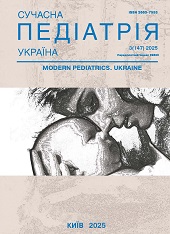Cardonate Kiddy in pediatric practice
DOI:
https://doi.org/10.15574/SP.2025.3(147).7477Keywords:
children, the dietary supplement «Cardonate Kiddy», oxidative stress, еnergy metabolismAbstract
Considering the modern living conditions of children in Ukraine (chronic stress, unbalanced nutrition, prolonged stays in bomb shelters, increased screen time due to remote learning), the question arises regarding the necessity to enhance the natural adaptive capabilities of the body by adding dietary supplements to the diet to improve the health of the country's child population.
Aim - to present the dietary supplement «Cardonate Kiddy» as an example of a combined metabolic drug for children from 3 years old.
The dietary supplement «Cardonate Kiddy» can be used as an additional source of amino acids carnitine, lysine and cysteine in combination with B vitamins and minerals: zinc, iodine, selenium in order to increase the adaptive capabilities and general reactivity of the body, to maintain the normal functioning of the cardiovascular and nervous systems, normal cognitive function of the brain, increase endurance under increased physical and psycho-emotional stress, during the period of convalescence after illnesses, asthenic conditions of various origins, poor appetite, underweight, to reduce fatigue and fatigue, protect the cell from oxidative stress.
The research was carried out in accordance with the principles of the Helsinki Declaration.
No conflict of interest was declared by the author.
References
Alexander EK, Pearce EN, Brent GA et al. (2017, Mar). Guidelines of the American Thyroid Association for the diagnosis and management of thyroid disease during pregnancy and the postpartum. Thyroid. 27(3): 315-389. https://doi.org/10.1089/thy.2016.0457; PMid:28056690
Helton E, Darragh R, Francis P. et al. (2015). Metabolic aspects of myocardial disease and a role for L-carnitine in the treatment of childhood cardiomyopathy. Pediatrics. 125: 1260-1270. https://doi.org/10.1542/peds.105.6.1260; PMid:10835067
Ielisieieva Т. (2022). Selenium (Se) - Importance for Body and Health + Top 30 Sources. Journal of Healthy Eating and Dietetics. 1(19): 55-64. https://doi.org/10.59316/.vi19.160
Ielisieieva Т, Tkachova N. (2019). Cysteine - description, benefits, effects on the body and the best sources. Journal of Healthy Eating and Dietetics. 1; 7: 1-6. https://doi.org/10.59316/j.edpl.2018.7.33
Kosmynina NS, Lychkovska OL, Malska AA, Dats-Opoka MI. (2019). The role of zinc deficiency in the occurrence of thyroid pathology in children in an ecologically unfavorable iodine-deficient environment. Problems of endocrine pathology. 68(2): 34-39. https://doi.org/10.21856/j-PEP.2019.2.05
Leitão AMF, Silva BR, Barbalho EC, Paulino LRM, Costa FDC et al. (2024, Oct). The role of L-carnitine in the control of oxidative stress and lipid β-oxidation during in vitro follicle growth, oocyte maturation, embryonic development and cryopreservation: a review. Zygote. 32(5): 335-340. Epub 2024 Nov 7. https://doi.org/10.1017/S096719942400039X; PMid:39506889
Mojadadi A, Au A, Salah W, Witting P, Ahmad G. (2021, Sep 18). Role for Selenium in Metabolic Homeostasis and Human Reproduction. Nutrients. 13(9): 3256. https://doi.org/10.3390/nu13093256; PMid:34579133 PMCid:PMC8469766
Pekala J, Patkowska-Sokoła B, Bodkowski R, Jamroz D, Nowakowski P et al. (2011, Sep). L-carnitine - metabolic functions and meaning in humans life. Curr Drug Metab. 12(7): 667-678. https://doi.org/10.2174/138920011796504536; PMid:21561431
Rayman MP. (2012, Mar 31). Selenium and human health. Lancet. 379(9822): 1256-1268. Epub 2012 feb 29. https://doi.org/10.1016/S0140-6736(11)61452-9; PMid:22381456
Rutjes AWS, Denton DA, Di Nisio M, Chong LY, Abraham RP, Al‐Assaf AS et al. (2018). Vitamin and mineral supplementation for maintaining cognitive function in cognitively healthy people in mid and late life. Cochrane Database of Systematic Reviews. 12: CD011906. https://doi.org/10.1002/14651858.CD011906.pub2; PMid:30556597 PMCid:PMC6353240
Shareck M, Rousseau M-C, Koushik A, Siemiatycki J, Parent M-E. (2017). Inverse Association between Dietary Intake of Selected Carotenoids and Vitamin Cand Risk of Lung Cancer. Front. Oncol. 7: 23. https://doi.org/10.3389/fonc.2017.00023; PMid:28293540 PMCid:PMC5328985
Sorokman TV, Lozyuk IYa. (2021). Eating behavior and nutrition characteristics of preschool children. Modern Pediatrics. Ukraine. 5(117): 29-34. https://doi.org/10.15574/SP.2021.117.29
Thomas R, Siliquini, R, Hillegers MH, Jansen PW. (2020). The association of adverse life events with children's emotional overeating and restrained eating in a population based cohort. The International journal of eating disorders. 53(10): 1709-1718. https://doi.org/10.1002/eat.23351; PMid:32702148 PMCid:PMC7589411
Tkachuk VV, Velychko VI, Tkachuk IV. (2011). Iodine deficiency and iodine deficiency diseases. Practitioner. 10; 3: 45-50.
Vlasenko MV, Palamarchuk AV, Golovan AV. (2022). Use of Neurovitan in the Treatment of Endocrine Polyneuropathy. Іnternational journal of endocrinology (Ukraine). 3(59): 73-74. https://doi.org/10.22141/2224-0721.3.59.2014.76608
Wang Z-Y, Liu Y-Y, Liu G-H, Lu H-B, Mao C-Y. (2018). L-Carnitine and heart disease. Life Sciences. 194: 88-97. https://doi.org/10.1016/j.lfs.2017.12.015; PMid:29241711
Downloads
Published
Issue
Section
License
Copyright (c) 2025 Modern pediatrics. Ukraine

This work is licensed under a Creative Commons Attribution-NonCommercial 4.0 International License.
The policy of the Journal “MODERN PEDIATRICS. UKRAINE” is compatible with the vast majority of funders' of open access and self-archiving policies. The journal provides immediate open access route being convinced that everyone – not only scientists - can benefit from research results, and publishes articles exclusively under open access distribution, with a Creative Commons Attribution-Noncommercial 4.0 international license (СС BY-NC).
Authors transfer the copyright to the Journal “MODERN PEDIATRICS. UKRAINE” when the manuscript is accepted for publication. Authors declare that this manuscript has not been published nor is under simultaneous consideration for publication elsewhere. After publication, the articles become freely available on-line to the public.
Readers have the right to use, distribute, and reproduce articles in any medium, provided the articles and the journal are properly cited.
The use of published materials for commercial purposes is strongly prohibited.

